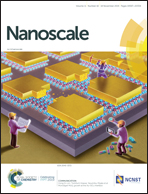Surface effects on a photochromic spin-crossover iron(ii) molecular switch adsorbed on highly oriented pyrolytic graphite†
Abstract
Thin films of an iron(II) complex with a photochromic diarylethene-based ligand and featuring a spin-crossover behaviour have been grown by sublimation in ultra-high vacuum on highly oriented pyrolytic graphite and spectroscopically characterized through high-resolution X-ray and ultraviolet photoemission, as well as via X-ray absorption. Temperature-dependent studies demonstrated that the thermally induced spin-crossover is preserved at a sub-monolayer (0.7 ML) coverage. Although the photochromic ligand ad hoc integrated into the complex allows the photo-switching of the spin state of the complex at room temperature both in bulk and for a thick film on highly oriented pyrolytic graphite, this photomagnetic effect is not observed in sub-monolayer deposits. Ab initio calculations justify this behaviour as the result of specific adsorbate–substrate interactions leading to the stabilization of the photoinactive form of the diarylethene ligand over photoactive one on the surface.



 Please wait while we load your content...
Please wait while we load your content...